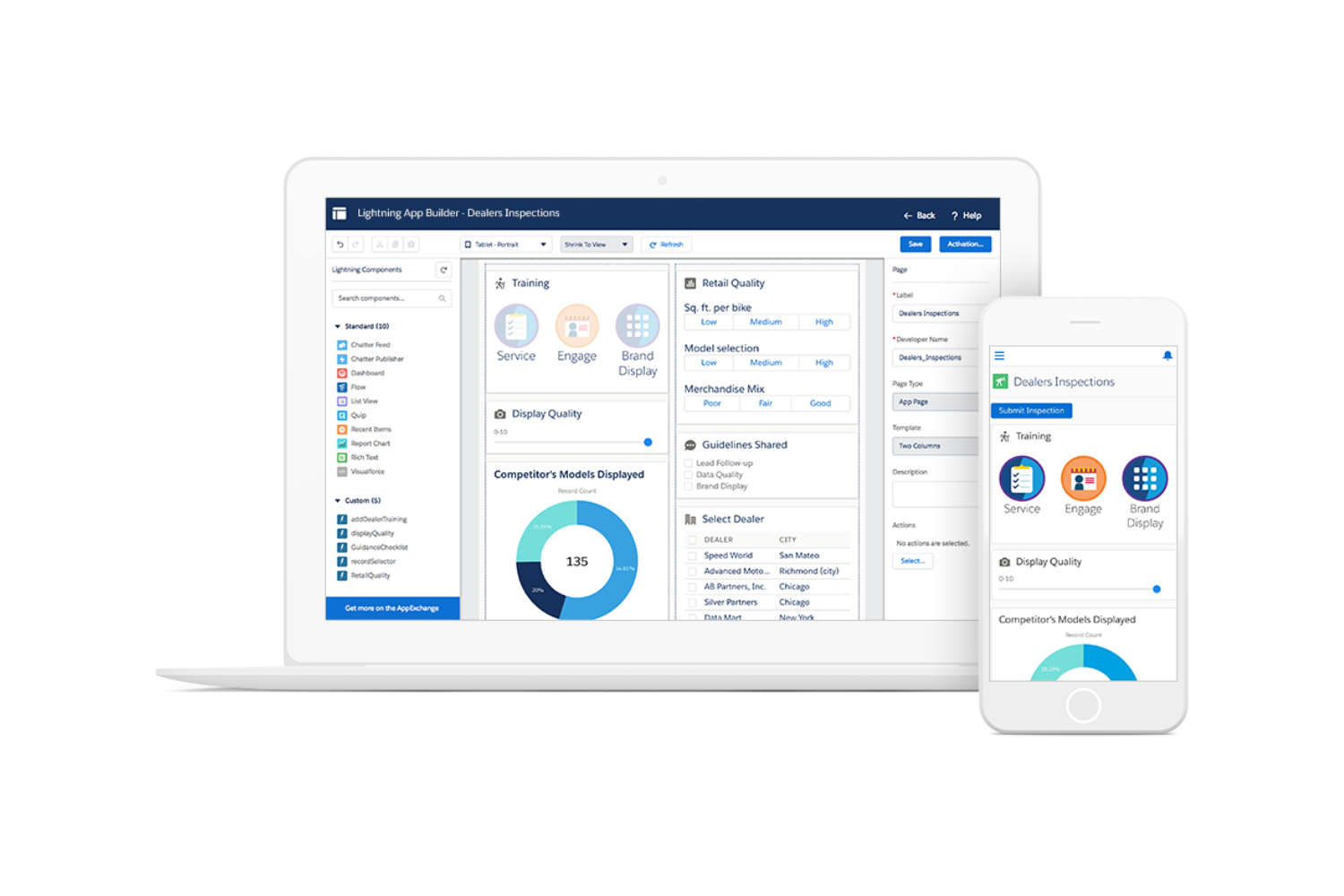Introduction
Welcome to the world of Software as a Service (SaaS) business! With the rise of digital technology and the increasing demand for online solutions, starting a SaaS business has become an enticing opportunity for entrepreneurs. SaaS businesses offer software applications that can be accessed and used remotely through the internet.
Building a successful SaaS business requires careful planning, strategic execution, and a customer-centric approach. In this article, we’ll guide you through the essential steps to start your own SaaS business from scratch. Whether you have a groundbreaking idea or you’re already exploring the possibilities, this guide will provide you with the necessary framework to turn your vision into a reality.
From developing a business idea to marketing and customer acquisition, we’ll cover all the crucial aspects that will set you on the path to success. Each step plays a vital role in the foundation and growth of your SaaS business, so be sure to pay close attention and implement the strategies that align with your unique vision and goals.
Starting a SaaS business can be an exciting and rewarding journey, but it’s essential to approach it with a clear understanding of the challenges and requirements involved. With determination, perseverance, and the right mindset, you can overcome obstacles and make your mark in the competitive SaaS industry.
So, without further ado, let’s dive into the step-by-step process of starting your own SaaS business and unleash your entrepreneurial spirit!
Step 1: Developing a Business Idea
The first and most crucial step in starting a SaaS business is developing a compelling business idea. Your idea will be the foundation on which your entire business is built, so it’s important to spend time brainstorming and evaluating potential opportunities.
Start by identifying a problem or pain point that your SaaS solution can address. Look for gaps in the market or areas where existing solutions are lacking. Conduct market research to validate the demand for your idea and ensure that there is a viable target audience.
Consider your own expertise and passion when developing your business idea. Building a successful SaaS business requires dedication and persistence, so choosing a niche that you are knowledgeable about and interested in will not only increase your chances of success but also make the journey more enjoyable.
Once you have a general idea, refine it by identifying the unique selling point (USP) of your SaaS product. What sets your solution apart from competitors? It could be a specific feature, a better user experience, or a more affordable pricing model. Clearly defining your USP will help you differentiate your product in the market and attract customers.
Additionally, consider the scalability and long-term potential of your business idea. Will your solution appeal to a wide range of customers? Is there room for growth and expansion in the future? These factors will contribute to the sustainability and profitability of your SaaS business.
Finally, evaluate the market size and competition in your chosen niche. While competition can be an indication of demand, too much competition might make it challenging to establish a foothold. Look for opportunities to carve out a unique position in the market where you can thrive.
Remember, developing a solid business idea is just the beginning. As you proceed with the other steps in starting a SaaS business, be open to iterating and refining your concept based on customer feedback and market trends. Flexibility and adaptability can be key factors in your success.
Step 2: Conducting Market Research
Market research is a crucial step in starting a SaaS business as it provides valuable insights into your target market, competitors, and customer needs. By conducting thorough market research, you can make informed decisions and develop a business strategy that resonates with your target audience.
Start by identifying your target market. Understanding who your potential customers are will enable you to tailor your product and marketing efforts to their specific needs. Conduct demographic research to determine the age, gender, location, and other relevant characteristics of your target audience. Identify their pain points and challenges, and how your SaaS solution can address them.
Next, analyze your competitors. Identify direct and indirect competitors in your niche and evaluate their offerings, pricing models, and marketing strategies. This will help you identify gaps in the market and areas where you can differentiate your product. Look for opportunities to offer unique features or better value to attract customers.
Gather feedback and insights from your target market through surveys, interviews, or focus groups. This will provide valuable information about customer preferences, expectations, and pain points. Use these insights to refine your product, pricing, and marketing strategies to better align with customer needs.
Additionally, research industry trends and market forecasts. Stay updated on emerging technologies, changes in customer behavior, and regulatory factors that could impact the SaaS industry. This will help you identify opportunities and navigate potential challenges as you develop and launch your SaaS product.
Utilize online tools and resources to conduct market research more efficiently. Digital platforms like social media, forums, and industry-specific websites can provide valuable data and insights about your target market and competitors. Take advantage of keyword research tools to understand search volume and competition for relevant keywords.
Remember that market research is an ongoing process. Continuously monitor your target market, customer feedback, and industry trends to stay ahead of the curve. Stay connected with your customers through surveys, feedback forms, and customer support channels to understand their evolving needs and make necessary adjustments to your SaaS offering.
By conducting thorough market research, you can position your SaaS business for success and ensure that your product meets the needs and expectations of your target audience.
Step 3: Creating a Minimum Viable Product (MVP)
In the world of SaaS, building a Minimum Viable Product (MVP) is a crucial step before launching your full-fledged product. An MVP is a simplified version of your SaaS solution that includes the core features and functionalities necessary to solve the pain points of your target audience.
The primary goal of an MVP is to gather feedback and validate your product idea with real users. By releasing an MVP, you can test the market response and iterate based on user feedback, ensuring that your final product meets the needs and expectations of your audience. This iterative approach saves time and resources, allowing you to refine your product while avoiding potential pitfalls.
When developing your MVP, focus on the core features that differentiate your product and provide value to your users. Avoid the temptation to add too many features at this stage, as it can slow down development and lead to unnecessary complexity. Keep it simple and concentrate on delivering the essential functionality that solves the pain points identified through market research.
Consider a lean and agile development approach to build your MVP. Break down larger tasks into smaller, manageable pieces known as user stories. This allows you to prioritize features and quickly iterate based on user feedback.
Ensure that your MVP has a user-friendly interface and provides a seamless user experience. User experience (UX) is crucial for customer satisfaction and adoption of your SaaS solution. Focus on simplicity, intuitive design, and smooth navigation to optimize the user journey.
During the development stage, actively involve your target audience in the process. Seek feedback early and often through user testing, surveys, and beta releases. By listening to your users and understanding their needs, you can refine your MVP and address any potential pain points before the full launch.
Remember, the MVP is not the final product but a stepping stone towards creating a robust and market-ready SaaS solution. Use the insights gained from user feedback and real-world usage to continuously iterate and improve your product. As you gather more data and refine your offering, you can gradually add additional features to enhance the user experience and meet evolving customer needs.
By creating and launching an MVP, you can validate your business idea, gain valuable user feedback, and build a solid foundation for the future growth of your SaaS business.
Step 4: Building a Team
Building a strong and talented team is essential for the success of your SaaS business. Collaborating with skilled professionals who share your vision and complement your own expertise can propel your business to new heights. Here’s how to build an effective team for your SaaS venture:
Identify key roles and responsibilities based on your business needs. Consider positions such as developers, designers, marketers, customer support representatives, and project managers. Determine the skills and experience required for each role and create detailed job descriptions for recruitment purposes.
Recruit individuals who are passionate about your industry and align with your company culture. Look for candidates who possess the necessary technical skills and have a track record of success in their respective fields. Seek out individuals who are proactive, adaptable, and eager to contribute to the growth of your SaaS business.
Consider utilizing online job boards, professional networks, and industry-specific platforms to advertise your job openings. Leverage your network and engage in targeted outreach to attract top talent. Don’t underestimate the power of referrals from your existing network, as they can often lead to finding highly qualified candidates.
During the interview process, assess not only the technical skills of the candidates but also their cultural fit and ability to work collaboratively within a team. Look for individuals who demonstrate strong communication and problem-solving skills, as these attributes are crucial for a cohesive and productive team dynamic.
Once you’ve assembled your team, establish clear roles and responsibilities to avoid ambiguity and promote accountability. Foster a culture of open communication and encourage team members to contribute their ideas and provide feedback. Regularly meet as a team to discuss progress, address challenges, and celebrate achievements.
Invest in ongoing professional development opportunities for your team. Encourage them to stay updated with industry trends, attend conferences, and participate in relevant training programs. By investing in the growth and development of your team members, you foster a culture of continuous learning and improvement.
Finally, prioritize employee satisfaction and well-being. Provide a positive work environment that promotes work-life balance and offers competitive compensation and benefits. Recognize and reward team members for their achievements and contributions to keep them motivated and engaged.
Remember, building a team is not just about finding skilled individuals, but also nurturing a collaborative and innovative work environment. A well-rounded team that works cohesively can significantly contribute to the success and growth of your SaaS business.
Step 5: Designing the User Interface (UI) and User Experience (UX)
The user interface (UI) and user experience (UX) play a vital role in the success of your SaaS product. A well-designed and intuitive interface can attract users, enhance satisfaction, and differentiate your solution from competitors. Here’s how to design an exceptional UI/UX for your SaaS business:
Start by understanding your target audience and their needs. Conduct user research to gain insights into their preferences, habits, and pain points. Use this information to create user personas and user journeys that guide your design decisions.
Keep the design simple and uncluttered. Focus on clarity and ease of use to create a seamless and intuitive user experience. Ensure that key features and functionalities are easily accessible and prominently displayed, eliminating any potential confusion or frustration.
Develop a consistent and visually appealing design language that reflects your brand identity. Use appropriate colors, typography, and imagery that resonate with your target audience. Maintain consistency in design across all pages and elements of your SaaS product to create a cohesive user experience.
Pay attention to the layout and organization of information. Use clear headings, logical grouping, and visual hierarchy to guide users’ attention. Place important elements and actions within easy reach to minimize effort and maximize efficiency.
Implement responsive design principles to ensure that your SaaS product is accessible and optimized for various devices and screen sizes. Consider the mobile experience and prioritize mobile-friendly design to accommodate users who prefer to access your product on their smartphones or tablets.
Prototype and test your UI/UX design with real users to gather feedback and make improvements. Conduct usability testing sessions to observe how users interact with your product and identify any usability issues. Incorporate user feedback into your design iterations to enhance the overall user experience.
Strive for a seamless and enjoyable onboarding process. Guide new users through the initial setup and familiarize them with key features and functionalities. Provide tooltips, tutorials, or on-screen guidance to assist users in getting started quickly and effectively.
Continuously monitor user engagement and behavior within your SaaS product. Leverage analytics tools to gather data on user interactions, navigation patterns, and areas of improvement. Use these insights to refine your UI/UX design and optimize the user experience over time.
Remember, the design of your UI/UX should prioritize user needs and align with your overall business objectives. By investing time and effort into creating a thoughtful and user-centric design, you can enhance user satisfaction, drive engagement, and differentiate your SaaS product in a competitive market.
Step 6: Choosing the Right Technology and Infrastructure
Choosing the right technology and infrastructure is a critical step in building a successful SaaS business. It sets the foundation for your product’s performance, scalability, and security. Here are key considerations for selecting the right technology and infrastructure:
Evaluate the scalability requirements of your SaaS product. Determine if your solution needs to handle a large number of users or if it requires the ability to scale resources based on demand. Choose technologies and infrastructure that can accommodate the anticipated growth of your user base without experiencing performance issues.
Consider the programming language and framework that best aligns with your development needs and expertise. Choose a technology stack that allows for efficient and agile development, while also considering the availability of resources, libraries, and community support.
Ensure that your chosen technology offers robust security measures. Security is of utmost importance for any SaaS business, as it involves handling sensitive user data. Implement measures such as encryption, secure authentication, and regular vulnerability assessments to protect user information and maintain their trust.
Evaluate the reliability and performance of infrastructure providers. Look for cloud hosting providers or data centers that offer high availability, redundancy, and disaster recovery options. Assess their uptime guarantees, service level agreements (SLAs), and support options to ensure that your SaaS product remains accessible to users at all times.
Consider the cost implications of your chosen technology and infrastructure. Calculate the upfront and ongoing expenses involved in using specific technologies and hosting solutions. Take into account factors such as licensing fees, maintenance costs, and scalability-related expenses to make an informed decision that aligns with your budgetary requirements.
Stay updated with emerging technologies and trends in the SaaS industry. Evaluate the feasibility of adopting new technologies that can enhance your product’s capabilities or streamline development processes. However, exercise caution and thoroughly assess the stability and maturity of these technologies before incorporating them into your SaaS product.
Identify and integrate with third-party APIs and services where necessary. Leverage existing tools and services to expedite development and enhance functionalities. However, ensure that these integrations are well-documented, reliable, and align with your overall product roadmap.
Consider future development and maintenance requirements. Choose technologies that have a vibrant developer community and a strong ecosystem. This ensures that you have access to ongoing support, updates, and libraries to keep your SaaS product up to date and adaptable as your business evolves.
Remember, the technology and infrastructure you choose for your SaaS business should align with your product requirements, security needs, scalability goals, and budgetary constraints. By carefully considering these factors, you can build a robust and reliable foundation for your SaaS product.
Step 7: Pricing and Monetization Strategy
Developing a pricing and monetization strategy is crucial for the success and sustainability of your SaaS business. It involves setting the right pricing models, determining value-based pricing, and creating a plan to generate revenue. Here’s how to craft an effective pricing and monetization strategy:
Conduct market research to understand the pricing landscape in your niche. Analyze the pricing models of your competitors and identify industry standards. Consider factors such as the size of your target market, the value your SaaS product provides, and the willingness of customers to pay for your solution.
Choose an appropriate pricing model that aligns with your target market and business goals. Common pricing models for SaaS businesses include per-user pricing, tiered pricing, usage-based pricing, and freemium models. Consider the scalability of your pricing model as your user base grows.
Decide whether to offer a free trial or a freemium offering. Offering users a taste of your product can help drive adoption and attract potential customers. However, evaluate the potential risks and benefits of providing a free or limited version of your SaaS product.
Implement value-based pricing that reflects the benefits and value your product delivers to customers. Consider the specific pain points your solution addresses, the time and resources it saves, and the return on investment it offers. Price your product in a way that captures the perceived value by your target market.
Understand your customers’ willingness to pay and test different pricing strategies. Experiment with pricing tiers, add-on features, or different packages to discover what resonates best with your target audience. Monitor customer feedback and market trends to make informed adjustments to your pricing strategy over time.
Consider offering discounts or promotional offers to attract customers during the early stages of your business. Launch special pricing campaigns or limited-time offers to create a sense of urgency and incentivize potential users to sign up or upgrade their subscription.
Implement a subscription management system and billing infrastructure that allows for easy and seamless payment processing. Consider partnering with payment gateways that provide secure and convenient payment options for your customers.
Regularly review and analyze your pricing strategy. Monitor the performance of different pricing tiers, evaluate customer retention and acquisition costs, and make data-driven decisions to optimize your pricing and maximize revenue.
Continuously iterate and adjust your pricing strategy based on market dynamics, changes in customer needs, and industry trends. Revisit your pricing periodically to ensure it remains competitive and aligned with the value your SaaS product offers.
Remember, crafting an effective pricing and monetization strategy requires a deep understanding of your target market, careful consideration of your product’s value, and continuous evaluation and adaptation. By setting the right price for your SaaS product, you can achieve a balance between profitability and customer satisfaction.
Step 8: Implementing Security Measures
Implementing robust security measures is paramount for any SaaS business to protect sensitive user data, gain customer trust, and comply with data protection regulations. Here’s how to effectively implement security measures for your SaaS product:
Conduct a thorough security assessment to identify potential vulnerabilities and risks within your SaaS infrastructure. Perform regular security audits to ensure that your systems are up-to-date, properly configured, and protected against known vulnerabilities.
Implement strong user authentication mechanisms, such as two-factor authentication (2FA) or multi-factor authentication (MFA). This ensures that only authorized users can access your SaaS product and prevents unauthorized access.
Encrypt user data both in transit and at rest. Utilize secure protocols such as HTTPS/TLS for data transmission over the internet, and implement strong encryption algorithms to safeguard data stored on servers or in databases. Regularly update encryption protocols and algorithms to stay ahead of security threats.
Employ access controls and permission management to limit user access to sensitive data and functionalities. Implement role-based access control (RBAC) to ensure that users have appropriate permissions based on their assigned roles and responsibilities.
Regularly back up user data to prevent data loss in the event of system failures, accidental deletions, or security breaches. Implement automated backup systems and test the restoration process to ensure data can be recovered effectively.
Implement intrusion detection and prevention systems (IDPS) to monitor network traffic and detect any suspicious activities or unauthorized attempts to access your SaaS infrastructure. Set up real-time alerts to respond promptly to any potential security incidents.
Stay informed about emerging security threats, vulnerabilities, and best practices in the industry. Regularly update and patch your software systems and dependencies to fix known security vulnerabilities. Implement a robust patch management process to ensure timely updates.
Train your employees and users on best practices for secure usage of your SaaS product. Educate them about password security, phishing attacks, and other common security threats. Continuously reinforce security awareness to create a security-conscious culture within your organization and customer base.
Implement regular security testing and penetration testing to proactively identify any weaknesses or vulnerabilities in your SaaS product. Engage with external security professionals or employ security testing tools to thoroughly evaluate the security posture of your systems.
Comply with relevant data protection and privacy regulations, such as the General Data Protection Regulation (GDPR) or the California Consumer Privacy Act (CCPA). Understand the requirements and obligations imposed by these regulations and ensure that your SaaS product is compliant.
Regularly communicate with your users about the security measures you have in place. Provide transparency regarding data handling, storage, and security practices to build trust and reassure users about the safety of their data.
Remember, security is a continuous process, and the threat landscape is constantly evolving. Stay updated with current security practices, frequently assess your security measures, and be proactive in addressing potential risks to ensure the integrity and security of your SaaS product.
Step 9: Marketing and Customer Acquisition
Effective marketing and customer acquisition strategies are essential for the growth and success of your SaaS business. A well-planned marketing approach can help you reach your target audience, generate leads, and convert them into paying customers. Here’s how to develop a solid marketing and customer acquisition strategy:
Define your target audience and create detailed buyer personas. Understand their demographics, pain points, motivations, and preferred communication channels. This allows you to tailor your marketing messages and strategies specifically to their needs and preferences.
Develop a compelling value proposition. Clearly communicate the value and benefits that your SaaS product offers to potential customers. Highlight how your solution solves their problems, enhances efficiency, or saves time and resources.
Build a strong online presence by optimizing your website for search engines (SEO). Conduct keyword research to identify relevant terms and incorporate them into your website content. Publish high-quality blog articles, case studies, and other valuable content that positions you as an industry expert and attracts organic traffic.
Utilize content marketing to educate and engage your target audience. Create informative and helpful content that addresses their pain points and showcases your expertise. Distribute your content through various channels, such as social media, email marketing, and industry forums.
Engage in social media marketing to connect with your target audience. Identify the social media platforms where your prospective customers are active and develop a strong presence on those channels. Share relevant content, engage with followers, and build a community around your brand.
Implement email marketing campaigns to nurture leads and convert them into customers. Build an email list by offering valuable content or exclusive offers to visitors on your website. Segment your email list based on user behavior and preferences to create personalized and targeted email campaigns.
Utilize paid advertising channels, such as search engine ads or social media ads, to increase your visibility and reach a wider audience. Set a budget, define your target audience, and optimize your ad campaigns to generate leads and drive conversions.
Leverage influencer marketing partnerships to expand your reach and build credibility. Collaborate with influencers or industry experts who have a strong following and engage with your target audience. Their endorsement can help create buzz and drive interest in your SaaS product.
Implement referral programs or affiliate marketing to encourage current customers or relevant partners to refer new customers to your SaaS product. Offer incentives or rewards for successful referrals, which can help generate leads and expand your customer base.
Engage in strategic partnerships with complementary businesses or industry influencers. Seek opportunities for co-marketing initiatives, joint webinars, or cross-promotion. Partnering with established brands or thought leaders in your industry can help you gain visibility and credibility.
Track and analyze your marketing metrics to evaluate the performance of your customer acquisition efforts. Monitor key metrics such as website traffic, lead conversion rate, customer acquisition cost (CAC), and return on investment (ROI). Use these insights to refine your strategies and allocate resources effectively.
Remember, marketing and customer acquisition are ongoing processes. Continuously monitor and adapt your strategies based on market trends, customer feedback, and the evolving needs of your target audience. By implementing effective marketing and customer acquisition strategies, you can generate sustainable growth and build a loyal customer base for your SaaS business.
Step 10: Providing Exceptional Customer Support
Providing exceptional customer support is a crucial aspect of running a successful SaaS business. It not only ensures customer satisfaction but also contributes to customer retention and referrals. Here’s how to deliver outstanding customer support:
Offer multiple channels of support to cater to different customer preferences. This can include email, live chat, phone support, or a dedicated customer support portal. Provide clear instructions for reaching out to your support team and promptly respond to customer inquiries.
Train your customer support team to be knowledgeable and empathetic. Ensure they have a deep understanding of your SaaS product, its features, and its common use cases. Empower them to resolve customer issues efficiently and effectively.
Develop comprehensive documentation, including user guides, FAQs, and video tutorials. Make these resources easily accessible to assist customers in troubleshooting common problems or learning how to use your product. Regularly update your documentation to keep up with product updates or new feature releases.
Implement a ticketing system or customer relationship management (CRM) software to track and manage customer inquiries. This ensures that no customer inquiry goes unnoticed and allows you to provide timely and personalized responses to each customer.
Set clear response time expectations and strive to meet or exceed them. Promptly acknowledge customer inquiries and provide regular updates on the status of their concerns or issues. Be transparent about any known problems or system downtime, and communicate proactively with customers to manage their expectations.
Encourage customer feedback and actively seek suggestions for improvement. Surveys, feedback forms, or regular check-ins can provide valuable insights into customer satisfaction and identify areas for improvement in your product or support processes.
Implement a customer success program to ensure ongoing engagement and adoption of your SaaS product. Proactively reach out to customers, provide personalized recommendations, and offer assistance in maximizing the value they derive from your solution. By helping customers achieve their goals, you increase their loyalty and strengthen the long-term relationship.
Monitor customer sentiment and conduct customer satisfaction surveys to gauge your performance. Use metrics like Net Promoter Score (NPS) or Customer Satisfaction (CSAT) scores to measure customer sentiment and identify areas for improvement. Act on customer feedback promptly to address any issues and continuously enhance your customer support processes.
Emphasize a customer-centric culture within your organization. Ensure that every employee understands the importance of exceptional customer support and how it contributes to the overall success of the business. Encourage a customer-first mindset and reward teams or individuals who go above and beyond in providing exceptional support.
Resolve customer issues with a focus on long-term solutions rather than short-term fixes. Identify root causes of recurring problems and implement measures to prevent them from happening again. Continuously improve your product and processes based on customer feedback, allowing for a better customer experience.
Remember, providing exceptional customer support goes beyond simply resolving issues. It involves building relationships, understanding customer needs, and proactively guiding them towards success. By prioritizing customer support, you can foster customer loyalty, advocacy, and further contribute to the growth of your SaaS business.
Conclusion
Congratulations on reaching the end of this comprehensive guide on starting a SaaS business! By following the ten essential steps outlined above, you have gained valuable insights and roadmap for embarking on a successful SaaS venture.
Starting a SaaS business requires careful planning, market research, and a customer-focused approach. From developing a compelling business idea and creating an MVP to implementing robust security measures and providing exceptional customer support, each step is crucial in building a solid foundation for your SaaS product.
Remember, the SaaS industry is highly competitive and constantly evolving. Stay agile and adaptable, continuously monitor market trends, and be open to iterating and refining your product and strategies based on customer feedback and market demands.
As you navigate the journey of building your SaaS business, embrace an entrepreneurial mindset, remain persistent, and learn from both successes and failures. Building a successful SaaS business takes time, dedication, and continuous effort.
Finally, surround yourself with a talented team, leverage the right technology and infrastructure, and implement effective marketing and customer acquisition strategies to drive growth and expand your customer base.
Now that you have the knowledge and tools to start your SaaS business, it’s time to take action and turn your vision into reality. Embrace the challenges, embrace innovation, and embrace the opportunity to make a mark in the dynamic and exciting world of SaaS.
Best of luck on your journey to building and growing a successful SaaS business!

























